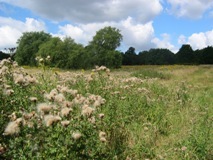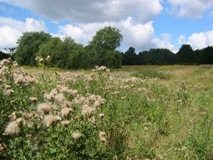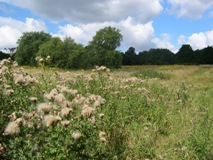
A big park for posh people? A mountain-biker's paradise? Inspiration to some of England's greatest painters and poets? Or a sordid playground for fornicating couples and sodomists? Whatever your opinion of Hampstead Heath, you're probably right. The 800 acres of grasslands, meadows, woodland, ponds and bogs are truly all things to all people, and stand as a verdant reflection of London's diversity in minicosm (being too large to count as a microcosm). The Heath has already seen a good deal of blogging action over the past week, with a first-rate account of the River Fleet's sources and courses, over on Diamond Geezer. But we'd like to bring you a broader guide, which should point you in the direction of some lesser-known Heathenalia.
So join us after the jump if you want to learn where in the wide, wide heath you might find a ghostly horse, a Henry Moore, a flock of parakeets, or a wallaby. The places to go if you want to engage in some dubious sexual practices, or track down the bullet holes at a notorious murder scene. Or even if you just want somewhere to take your parents or impress that first date. And we don't even mention that ruddy great chair and table…

Where To Go A-Ghost Hunting
There are plenty of shady, forgotten parts of the Heath, where the suggestible and credulous would be easily spooked. Strangely, though, some of the more celebrated spectres are to be found in the most public of places. The Highgate bathing ponds, for one, where swimmers have reported mysterious footsteps walking along the piers. These are attributed to the lost souls of the many suicides who have ended their lives in the ponds. And then, of course, there's that phantom dog off of Spaced. But there's a certain flavour of apparition that the Heath is particularly associated with: the shades of highwaymen.
Three centuries ago, transport in and around London came with its own risk of terrorism. In those days, it took the form of highway robbery, and the Heath was an irresistable draw for murderous highwaymen. Chief amongst them, of course, was Dick Turpin. Rumour has it, even if hard evidence does not, that the notorious rogue was born in 1705 at the Spaniard's Inn ('stand and deliver' the midwife was implored). Certainly, it seems Turpin's father was landlord here in the 18th Century. The Turpin Bar, upstairs, is said to frequently turn unnaturally cold (though that's probably due to the Victorian glazing) as the ghostly figure of the highwayman drifts across his erstwhile bedroom. In the downstairs bar, people have reported phantom tugs at their sleeves. The culprit is thought to be the spirit of 'Black Dick', an early hit-and-run victim who died outside the pub in the 18th Century. (We attempted further research, but became distracted whilst Googling his name.) As if that weren't enough, the car park contains a phantom horse (wasn't that a scene from Rentaghost?) and the gardens are haunted by a mysterious woman in white.

Where To Engage In A Bit Of Rumpy-Pumpy
Few guidebooks to the Heath mention the copious shagging that goes on, though the area is widely renowned for its coital activities. Most notoriously, the area known as West Heath is particularly famed for its gay cruising. The goings-on are so well established that it would now be unsurprising if they were listed in Time Out. To reach the hotspot follow the mud track at the back of Jack Straw's Castle (see how we maturely spurn the opportunity to slip into double-entendre?) as the sun is going down. It's all very well organised and non-threatening. Unwittingly finding ourselves passing through, we were offered health advice and extra-strong condoms by the Terrence Higgins Trust, who had a little booth. If only they also provided leaflets on environmental awareness. It's hard to miss the spent rubbers and discarded wrappers during a daytime stroll through these woods. Meanwhile, the Heath also affords many opportunities for the more mainstream forms of al freso bonking. The long grasses between South Meadow and Kenwood seem to be particularly popular, along with some of the less-open parts of West Meadow. Not that we've been looking, you understand. Finally, we hear that illicit skinny dipping in the Hampstead bathing ponds is an incredibly popular activity in the wee small hours, though we're too a-feared of the ghosts to give it a try!

Where To Impress A Date
There is no better place in London to flaunt your romantic credentials than the Pergola and Hill Garden on West Heath (East of Golders Hill Park). Ascend spiral staircases and stroll down wisteria-lined colonnades, admiring the surroundings whilst trying to stop your repeatedly dropping jaw from cracking the pavement. Nine times out of ten there will be nobody else around in this little-advertised marvel. Perfect, then, for that amorous liaison with the girl from accounts you've been trying to kiss. She's not worth it, but the stunning finale view of distant Harrow most certainly is. Just don't stray too far into West Heath unless you know what you're getting yourself into (see section on rumpy-pumpy).

Where To Take The Folks
Kenwood House is the natural choice here. Originally built in 1640, the house was later remodelled into the Neo-Classical form we see today. Within are sumptuous paintings by the likes of Rembrandt, Vermeer and Gainsborough. Without are sculptures by Henry Moore, Barbara Hepworth and Eugene Dodeigne. If your folks are into gardening (and whose aren't?) they'll have, literally, a field day here. The grounds are littered with exotic trees and shrubs, including a zelkova, and swamp cypress. The huge rhododendrons to the west of the house should also be visited, particularly in early summer when they are humming with diverse pollinating insects. After spending a pleasant afternoon picnicking on Kenwood's lawn, stick around for one of the evening concerts. Coming up soon, the Bootleg Beatles and Katie Melua, with the not-to-be-missed Last Night of the Kenwood Proms on 28 August.

Where To Spot Wildlife
Bill Oddie is a famous Hampstead resident, and it's with good reason that the celebrated twitcher makes his home in the area. Because of its size, there are many parts of the Heath that are normally overlooked by visitors, where wildlife flourishes. One of our favourite spots has to be the dense woodland between the mixed bathing pond and the viaduct pond, where a small brook trickles West to East. If you spend just 15 minutes sitting here quietly on a fallen tree, you're guaranteed to see a wealth of small mammals, insects and birds, including woodpeckers and jays. There are squirrels everywhere.
If you feel a bit of a plonker lurking in the bushes, perhaps wander over to one of the many larger bodies of water that dimple the Heath. The enchantingly named Highgate Number 1 pond is something of a bird sanctuary, with colonies of warblers and buntings, and even a cormorant or two. The Leg of Mutton pond over on West Heath is particularly sheltered from noise, and attracts a variety of wildfowl including the slightly sinister tufted ducks. For those who prefer to see their animals locked away in cages, have a walk around the adjoining Golders Hill Park, where you can see wallabies, muntjac and exotic birds slowly slip-sliding into a claustrophobic dementia. Perhaps their spirits would be lifted if they knew about the thriving population of escapees over at the other end of the Heath. In the depression to the East of the Kenwood estate, listen out for the distinctive call of the ring-necked parakeet. A flourishing population of these bright green birds seems to have established itself in this patchy meadow, though they're still nowhere near as abundant as their cousins over in Richmond Park.

Where To Have A Decent Pint
Without question, the Spaniard's Inn is THE place to freshen up and wind down after a long day's walking on the Heath. It has history, atmosphere, a cracking beer garden and a small aviary (which was boarded up on our most recent visit – perhaps the source of the parakeets from the last section). You'll find it to the West of the Kenwood Estate on the Spaniards Road. Alternatively, try the Old Bull and Bush, on North End Road. This lesser boozer does have the distinction of having a Tube station named after it, although you might struggle to locate it on the Underground map. The station was built as part of the Northern Line in the early 20th Century, but was never opened after plans for nearby housing estates were not realised. Read an excellent account of a site visit here. Hampstead itself is replete with smashing drinking dens. Check out Fancyapint.com or Beerintheevening.com for recommendations.
If you find yourself in need of an outdoor tipple whilst at the Southern end of the Heath, you could do a good deal worse than to visit the Freemasons Arms on the beautiful Downshire Hill. The Freemason's offers a range of Bass beers, with plenty of space in the garden and the unusual draw of a skittles court (although this always seems to be closed when we visit). In the same area, the ghoulish punter might care to inspect the bullet holes on the walls of the Magdala (South Hill Park), a memento from the day Ruth Ellis shot her lover here in the 1950s.

Where To Get The Best Views
Forget Parliament Hill. Everyone and his dog (literally) hikes up this mound to get an eyeful of London, and perhaps fly a kite. For the perfect panorama, seek out the hilltop just to the East of the Kenwood Estate's northern fringes. Here you get much the same view, but perfectly framed between banks of evergreens. Alternatively, sit beneath the pine trees above the Vale of Health for an outlook that takes in both the City and Canary Wharf (pictured).

Where To Go Foraging
Fans of Ray Mears will be glad to hear that Hampstead Heath presents many opportunities for foraging, above and beyond the ubiquitous brambles. Watch out for fruiting blackthorns in late summer (particularly along the paths North of the Hampstead ponds). These 'sloe' berries can be used to make jams and preserves as well as sloe gin. Meanwhile, blackberries can be found around the ladies bathing pond to the North-East.
For a more unusual harvest, seek out the pair of wild service trees (also known as a chequers), which grow close to Bird Bridge over in East Heath. They stand as the fifth and ninth trees in a line of boundary oaks, directly South of the Viaduct Road. These ancient trees bear small brown fruits in the Autumn, which, when left to over-ripen, have a distinctive, almost tropical taste.
Wild mushrooms can be found on all parts of the Heath, but always consult a good field guide before putting them anywhere near your mouth. The painfully named fungi to be with website devotes mushroom to the subject (sorry!), and gives details of guided walks around the Heath in search of fungi.
Do you have a favourite place on the Heath, or know about something special up there that we should have covered? Please do let us know using the comments form.




